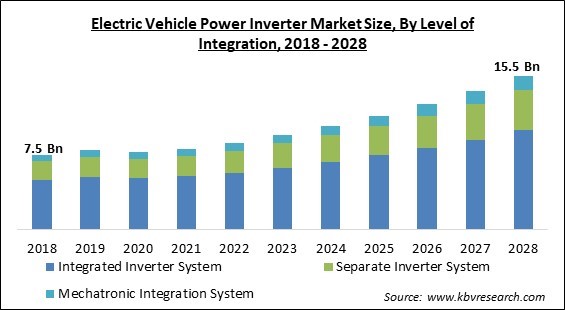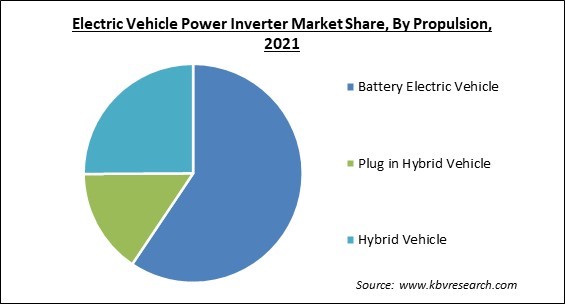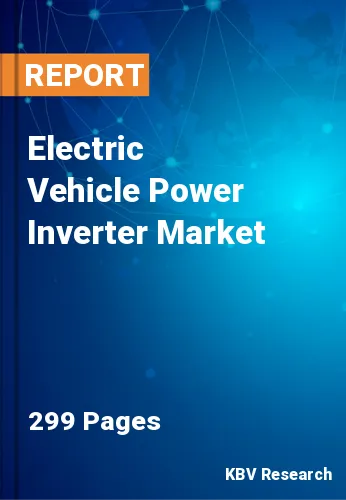The Global Electric Vehicle Power Inverter Market size is expected to reach $15.5 billion by 2028, rising at a market growth of 10.1% CAGR during the forecast period.
An electric vehicle power inverter is a system that is employed to run an EV motor, in which, the direct current electricity utilized in an electric car motor is converted to alternating current. By modulating the alternating current's frequency, the inverter can modify the motor's rotational speed. By changing the signal's amplitude, the motor's power or torque can also be increased or decreased.

The use of power inverters in electric vehicles is more widespread. Motors then make use of the converted current to drive appropriate equipment and sensors, which run on AC. Additionally, plug-in outlets as well as other conventional 120-volt devices can use electricity in electric automobiles. The electric vehicle power inverter market is anticipated to expand at a faster rate in the coming years due to factors, including rising demand for electric vehicles, strategic government initiatives for the use of electric vehicles, and exponential growth in demand for low-emission and fuel-efficient vehicles.
Electric vehicle power inverters need to be as tiny and light as feasible, able to tolerate high temperatures, and able to deliver high power (between 80 and 200+ kW) to the motor. High levels of functional safety to safeguard the driver and systems, high levels of efficiency to extend battery life, and small size and light weight are key performance criteria for inverters.
In order to power the propulsion motor, which is a 3-phase inductive load, the inverter transforms energy from the high-voltage battery into a multiphase AC current. In order to achieve energy and high reliability, the electronics in the inverter precisely control, monitor, and protect the high-power switches. This allows them to efficiently and precisely control the motor torque and speed and it enables the highest level of functional safety in accordance with ISO 26262 requirements.
Governments all over the world were driven by the COVID-19 outbreak to impose strict import-export bans and lockdowns for the majority of the year and a few months of 2021 as well. This caused the supply of crucial raw materials for components to suddenly diminish. The COVID-19 pandemic severely disrupted supply chains and manufacturing schedules, which had an adverse effect on aviation production and sales, which in turn had a detrimental effect on the market for electric car power inverters.
Electric vehicles have a number of benefits, including lower operating costs than conventional gasoline engines, the implementation of strict government regulations to reduce environmental pollution, and a reduction in tailpipe emissions, all of which have a significant positive impact on demand for them across the world. Key market players for electric car power inverters are also making a variety of strategic measures, such as product development and product launch, to capitalize on the market opportunity.
One of the most prevalent issues in the modern era is the worsening condition of climate. Industrialization, urbanization, and a number of other factors are responsible for degrading the quality of the environment and air. However, governments and people all over the world are taking initiatives in order to address this challenge. Due to issues, like climate change and initiatives to attain net zero emissions, the market for electric vehicles has developed dramatically.
For electric car adoption, strong infrastructure for charging EVs is required. Despite their advantages from an environmental and financial standpoint, electric vehicles have not yet become mainstream. The electric vehicle business is constrained by a lack of charging outlets. In order to increase the sales of electric vehicles, a country needs a significant number of charging stations at particular distances. As a result, the growth of electric vehicles is halted, which makes it difficult for the market for electric vehicle power inverters to thrive.
Based on Propulsion, the Electric Vehicle Power Inverter Market is segregated into Hybrid Vehicle, Plug in Hybrid Vehicle, and Battery Electric Vehicle. In 2021, the hybrid vehicle segment recorded a significant revenue share of the electric vehicle power inverter market. A hybrid vehicle is one that draws its power from two or more different sources, such as submarines that operate on batteries when submerged and diesel when they are surfaced.

On the basis of Inverter Type, the Electric Vehicle Power Inverter Market is classified into Traction Inverter and Soft Switching Inverter. In 2021, the traction inverter segment witnessed the largest revenue share of the electric vehicle power inverter market. The traction inverter's function is to change the DC current from the battery of an electric car into AC current so that it may be utilized to power the electric motor that powers the car's propulsion system.
By Vehicle Type, the Electric Vehicle Power Inverter Market is divided into Passenger Vehicle and Commercial Vehicle. In 2021, the commercial vehicle segment registered a significant revenue share of the electric vehicle power inverter market. The increasing growth of this segment primarily owing to the rapid surge in the growth of the electric vehicle power inverter market. Any motor vehicle used to deliver goods or carry passengers qualifies as a commercial vehicle.
On the basis of Level of integration, the Electric Vehicle Power Inverter Market is segmented into Integrated Inverter System, Separate Inverter System, and Mechatronic Integration System. In 2021, the integrated inverter system segment held the highest revenue in the electric vehicle power inverter market. Its structure largely consists of integrating an output current shaping function and recently developed maximum point tracking technique into a converter formed from a buck-boost and then inverting the shaped current across a grid frequency bridge to the grid.
By Distribution Channel, the Electric Vehicle Power Inverter Market is bifurcated into OEM and Aftermarket. In 2021, the OEM segment acquired the largest revenue share of the electric vehicle power inverter market. The primary advantage of OEM items is their cost. OEM products drastically lower the cost of production due to economies of scale. Additionally, the business buying these items can use them to create systems without having to run their own factories and this factor is propelling the growth of this segment of the market.
| Report Attribute | Details |
|---|---|
| Market size value in 2021 | USD 8.1 Billion |
| Market size forecast in 2028 | USD 15.5 Billion |
| Base Year | 2021 |
| Historical Period | 2018 to 2020 |
| Forecast Period | 2022 to 2028 |
| Revenue Growth Rate | CAGR of 10.1% from 2022 to 2028 |
| Number of Pages | 299 |
| Number of Tables | 500 |
| Report coverage | Market Trends, Revenue Estimation and Forecast, Segmentation Analysis, Regional and Country Breakdown, Companies Strategic Developments, Company Profiling |
| Segments covered | Inverter Type, Propulsion, Level of Integration, Vehicle Type, Distribution Channel, Region |
| Country scope | US, Canada, Mexico, Germany, UK, France, Russia, Norway, Netherlands, China, Japan, India, South Korea, Singapore, Taiwan, Brazil, Argentina, UAE, Saudi Arabia, South Africa, Nigeria |
| Growth Drivers |
|
| Restraints |
|
Region-wise, the Electric Vehicle Power Inverter Market is segregated into North America, Europe, Asia-Pacific, and LAMEA. In 2021, Asia-Pacific accounted for the largest revenue share of the electric vehicle power inverter market. The electric vehicle power inverter market is expanding quickly in China and India owing to the rapid expansion of the automotive industry in the region as well as government subsidies and incentives for electric vehicles.
Free Valuable Insights: Global Electric Vehicle Power Inverter Market size to reach USD 15.5 Billion by 2028
The market research report covers the analysis of key stake holders of the market. Key companies profiled in the report include Siemens AG, Continental AG, Robert Bosch GmbH, Denso Corporation, Valeo SA, Mitsubishi Electric Corporation, Aptiv PLC, Toyota Industries Corporation, Nissan Motor Corporation and Marelli.
By Inverter Type
By Propulsion
By Level of Integration
By Vehicle Type
By Distribution Channel
By Geography
The global Electric Vehicle Power Inverter Market size is expected to reach $15.5 billion by 2028.
Rising Adoption Of Electric Vehicles are driving the market in coming years, however, Lack Of Appropriate Infrastructure For Evs restraints the growth of the market.
Siemens AG, Continental AG, Robert Bosch GmbH, Denso Corporation, Valeo SA, Mitsubishi Electric Corporation, Aptiv PLC, Toyota Industries Corporation, Nissan Motor Corporation and Marelli.
The expected CAGR of the Electric Vehicle Power Inverter Market is 10.1% from 2022 to 2028.
The Battery Electric Vehicle segment acquired maximum revenue share in the Global Electric Vehicle Power Inverter Market by Propulsion in 2021 thereby, achieving a market value of $9 billion by 2028.
The Asia Pacific market dominated the Global Electric Vehicle Power Inverter Market by Region in 2021, and would continue to be a dominant market till 2028; thereby, achieving a market value of $6.35 billion by 2028.
Our team of dedicated experts can provide you with attractive expansion opportunities for your business.

